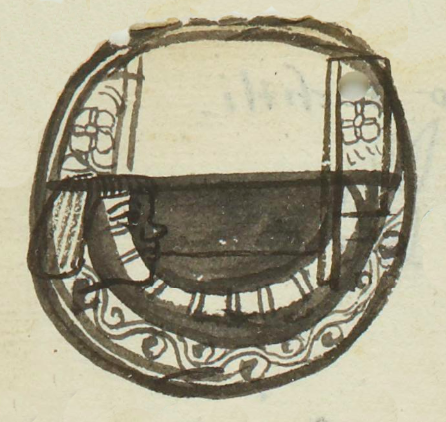Tlamauhco (MH660r)
This black-line drawing of the simplex glyph for the place name Tlamauhco (“Place of Wise Men”) stands out for exceptional design detail on what could be called a starry eye or stellar eye, an eye that can double for a star. The design features includes a white stripe below the black iris of the eye. This white stripe has perpendicular double hash marks that are reminiscent of the apantli (canal) or occasional atl (water) glyph. On the left and right sides of the eye are banners or flags (pamitl) with quincunx shaped flowers, reminiscent of some tonalli glyphs. Along the bottom of the iris is another white band; this one has undulating curling symbols, more decorative than hieroglyphic. Peeking through the designs on this starry eye is the head of the centecpanpixqui (guardian of twenty tribute payers) that was going to be listed in this spot. The flag with the flower on the right side of the eye may have been the hieroglyph for his personal name. He got moved over to the right of the contents of our contextualizing image, where he is shown with his wife.
Stephanie Wood
If the iris is intentionally decorated like water, it may be to provide a phonetic indicator for the “a” in Tlamauh. This eye is also called the starry eye or stellar eye, given how it can double as a star in the sky. This connection with celestial phenomena may relate to the meaning of the place name. The name seems to derive from tlamati, supposedly to "practice trickery or sorcery", but also to know someething. However, the translation of sorcery may reveal a Christian bias on the part of the friar Alonso de Molina, and really the Nahuas saw the Tlamauh- (or Tlamao) as being wise, perhaps like a priest. Supporting this, the use of the eye (ixtli) for the glyph calls forth the verb ixtlamati, to be wise, prudent. Furthermore, Marc Thouvenot (2010, 178–181) explains how iximati (which can become imati, to manage cleverly or create skillfully) compares to mati (to know). Imati involves knowing through seeing, much like conocer might indicate in Spanish, and mati is "to know" as in saber in Spanish. Once again, then, the eye glyph is a semantic indicator for a place of wisdom.
tlamaoco.ba
rro
Tlamauhco, barrio
Stephanie Wood
1560
Jeff Haskett-Wood
ojos, eyes, stars, estrellas, conocimiento, sabiduría, tlamao, tlamauh, nombres de lugares, barrios, topónimos

tlamauh, wise one, knowledgeable person, or possibly sorcerer, https://nahuatl.wired-humanities.org/content/tlamauh
tlamauh(tli), crazed, berzerk, or infected, https://nahuatl.wired-humanities.org/content/tlamauhtli
ix(tli), eye, https://nahuatl.wired-humanities.org/content/ixtli
ixtlamati, to be wise, prudent, https://nahuatl.wired-humanities.org/content/ixtlamati
tlamati, to know something, or to know sacred powers (verb), https://nahuatl.wired-humanities.org/content/tlamati
tlamatini, a sage, wise person, scholar, https://nahuatl.wired-humanities.org/content/tlamatini
tlama, someone knowledgeable, also a medico, https://nahuatl.wired-humanities.org/content/tlama-0
El Lugar de Sabios
Stephanie Wood
Matrícula de Huexotzinco, folio 660r, World Digital Library, https://www.loc.gov/resource/gdcwdl.wdl_15282/?sp=400&st=image
This manuscript is hosted by the Library of Congress and the World Digital Library; used here with the Creative Commons, “Attribution-NonCommercial-ShareAlike 3.0 License” (CC-BY-NC-SAq 3.0).









